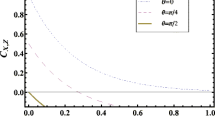Abstract
A protocol for quantum energy teleportation (QET) is known for a so-called minimal spin-\(\frac{1}{2}\) particle pair model. We extend this protocol to explicitly admit quantum weak measurements at its first stage. The extended protocol is applied beyond the minimal model to spin-\(\frac{1}{2}\) particle pairs whose Hamiltonians are of a general class characterized by orthogonal pairs of entangled eigenstates. The energy transfer efficiency of the extended QET protocol is derived for this setting, and we show that weaker measurement yields greater efficiency. In the minimal particle pair model, for example, the efficiency can be doubled by this means. We also show that the QET protocol’s transfer efficiency never exceeds 100 %, supporting the understanding that quantum energy teleportation is, indeed, an energy transfer protocol, rather than a protocol for remotely catalyzing local extraction of system energy already present.




Similar content being viewed by others
References
Bennett, C.H., Brassard, G., Crepeau, C., Jozsa, R., Peres, A., Wootters, W.K.: Teleporting an unknown quantum state via dual classical and Einstein–Podolsky–Rosen channels. Phys. Rev. Lett. 70, 1895 (1993)
Hotta, M.: A protocol for quantum energy distribution. Phys. Lett. A 372, 5671–5676 (2008)
Hotta, M.: Quantum measurement information as a key to energy extraction from local vacuums. Phys. Rev. D 78, 045006 (2008)
Hotta, M.: Quantum energy teleportation in spin chain systems. J. Phys. Soc. Jpn. 78, 034001 (2009)
Yusa, G., Izumida, W., Hotta, M.: Quantum energy teleportation in a quantum Hall system. Phys. Rev. A 84, 032336 (2011)
Pusz, W., Woronowicz, S.L.: Passive states and KMS states for general quantum systems. Commun. Math. Phys. 58, 273 (1978)
Frey, M., Gerlack, K., Hotta, M.: Quantum energy teleportation between Gibbs particles in a Gibbs state. J. Phys. A 46, 455304 (2013)
Yu, T., Eberly, J.H.: Evolution from entanglement to decoherence of bipartite mixed X states. Quantum Inform. Comput. 7(5), 459–468 (2007)
Fano, U.: Description of states in quantum mechanics by density matrix and operator techniques. Rev. Mod. Phys. 29, 74 (1957)
Aharonov, Y., Albert, D.Z., Vaidman, L.: How the result of a measurement of a component of the spin of a spin-1/2 particle can turn out to be 100. Phys. Rev. Lett. 60(14), 1351 (1988)
Aharonov, Y., Cohen, E., Elitzur, A.C.: Foundations and applications of weak quantum measurements. Phys. Rev. A 89(5), 052105 (2014)
Tamir, B., Cohen, E.: Introduction to weak measurements and weak values. Quanta 2(1), 7–17 (2013)
Oreshkov, O., Brun, T.A.: Weak measurements are universal. Phys. Rev. Lett. 95(11), 110409 (2005)
Doherty, A.C., Jacobs, K., Jungman, G.: Information, disturbance, and Hamiltonian quantum feedback control. Phys. Rev. A 63(6), 062306 (2001)
Frey, M., Funo, K., Hotta, M.: Strong local passivity in finite quantum systems. Phys. Rev. E 90, 012127 (2014)
Lenard, A.: Thermodynamical proof of the Gibbs formula for elementary quantum systems. J. Stat. Phys. 19(6), 575–586 (1978)
Author information
Authors and Affiliations
Corresponding author
Appendix
Appendix
We prove that the QET protocol’s efficiency \(\eta (\pi ,s)\) in (15) is a non-increasing function of the measurement strength \(s\) for any particle pair \(\mathcal{P}\) initially in the ground state \(\rho = |E_0\rangle \langle E_0|\) with parameters \(\pi \). The derivative of \(\eta (\pi ,s)\) in (16) is
where
with \(P_1,P_2,P_3\) and \(Q\) given as in (17), and \(\tilde{s}^{\prime }=s/\sqrt{1-s^2} \ge 0\). We have \(E_0 \le E_1 \le E_2 \le E_3\), so
Therefore, \(L \ge 0\) in (35), and the derivative of \(\eta (\pi ,s)\) in (34) is non-positive if and only if \(L^2 \ge R^2\). So consider
In (36), we have
Therefore, \(L^2 - R^2 \ge 0\) in (36), so the derivative in (34) is non-positive. \(\square \)
Rights and permissions
About this article
Cite this article
Frey, M.R. Efficiency of quantum energy teleportation within spin-\(\frac{1}{2}\) particle pairs. Quantum Inf Process 15, 1103–1116 (2016). https://doi.org/10.1007/s11128-015-0953-9
Received:
Accepted:
Published:
Issue Date:
DOI: https://doi.org/10.1007/s11128-015-0953-9




